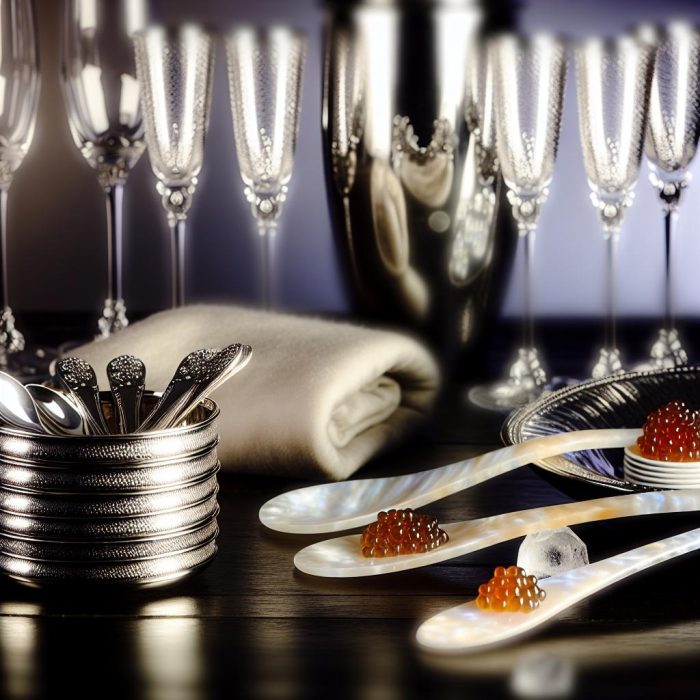Understanding Caviar Service
When it comes to serving caviar, using the right utensils is essential not only to preserve its delicate flavor but also to ensure a proper presentation. The choice of serving utensils can significantly enhance the caviar tasting experience by ensuring that the delicacy’s natural flavors are unimpeded and truly savored.
The Importance of Non-Metallic Utensils
Caviar is composed of sensitive fish eggs, which can react with certain metals, potentially altering the taste and reducing the quality of the caviar. Therefore, traditional caviar service prioritizes the use of utensils made from non-metallic materials. Common choices for these utensils include mother-of-pearl, bone, horn, and glass. These materials do not interfere with the taste of caviar, often setting the standard in culinary presentations focusing on luxury and refinement.
Mother-of-Pearl Spoons
Mother-of-pearl spoons are highly recommended as a choice for serving caviar. Their allure lies not only in their natural beauty and iridescence but also in their biological inertness. Because they will not interfere with the taste of caviar, they are popularly used in fine dining establishments to maintain the authentic flavors of caviar. High-quality mother-of-pearl utensils can often be found in renowned specialty culinary stores, catering to those invested in a premier dining experience.
Bone and Horn Spoons
Using spoons made from bone and horn is another prevalent practice, serving as an alternative in preventing any disturbance in flavor. Known for their robustness, these materials are frequently crafted into elegant utensils that not only serve a functional purpose but also add a touch of tradition and sophistication to the caviar service.
Glass and Crystal Utensils
Another favored choice among caviar aficionados includes utensils made from glass and crystal. Their transparent nature provides a contemporary appearance, allowing the caviar’s fine colors to remain visible, thus enhancing its visual appeal. These materials ensure that there is no chemical interaction with the caviar, making them excellent options for preserving the delicate balance of flavors.
Avoiding Metallic Utensils
Although commonplace, silver, stainless steel, and other metals are best avoided when serving caviar. These materials can easily impart a metallic taste, which is undesired and can diminish the inherent flavors of caviar. The investment in non-metallic utensils should be seen not merely as a consideration of etiquette but as an indispensable factor in ensuring a pristine and unadulterated caviar tasting experience.
Additional Serving Recommendations
While the choice of utensils is undeniably significant, there are other important elements to consider when it comes to caviar service:
Chill the Caviar Properly
Caviar must be stored and served chilled, but not frozen. Maintaining the ideal temperature is crucial, and this can be achieved by using a serving dish filled with crushed ice. Such a method ensures that the caviar remains at its optimal temperature, which is critical for savoring its rich texture and flavor.
Portion Control
Traditionally, caviar is served in small portions to allow the distinct flavors to be thoroughly appreciated. It is customary to serve caviar in increments of 1 to 2 ounces, allowing diners to savor the subtleties of taste with each bite.
The Accompaniments
In addition to selecting the suitable utensils, attention must be given to the accompaniments as well. Popular pairings include blinis, toast points, or unsalted crackers. These elements are selected to enhance, rather than overpower, the flavors of caviar. The inclusion of finely minced onions, hard-boiled eggs, or crème fraîchè is equally traditional, contributing to the richness of the overall culinary experience.
Pacing the Tasting Experience
The enjoyment of caviar is a sensory journey and thus should be paced accordingly. Taking the time to savor each bite provides an opportunity to fully appreciate the unique layers and complexities of flavor that caviar offers. By deliberately slowing the tasting experience, the nuances of the delicacy can be more thoroughly enjoyed, providing an elevated dining experience.
Investing in high-quality serving utensils such as mother-of-pearl spoons and glass serving dishes is vital for those exploring the nuances of caviar. This ensures that the delicacies of taste and presentation are preserved and enjoyed to their fullest potential, allowing each caviar service to be not just a meal, but a memorable occasion in culinary refinement.
The Visual and Sensory Experience
When serving caviar, the visual presentation cannot be understated. The bright hues of caviar are best displayed against a contrasting and aesthetically pleasing background. A pristine display enhances the luxury experience that caviar embodies. The use of non-metallic bowls and trays ensures that the sensory experience is refined, with the delicate nature of the eggs taking center stage.
Conclusion
Ultimately, understanding caviar service is about embracing the ceremonial nature of this gourmet tradition. Every aspect, from utensil choice to presentation, plays a role in crafting a concentrated moment of gastronomic pleasure. By focusing on the harmonious integration of all these elements, the timeless appeal of caviar can be acknowledged, savored, and celebrated according to its stature in the world of fine dining.

